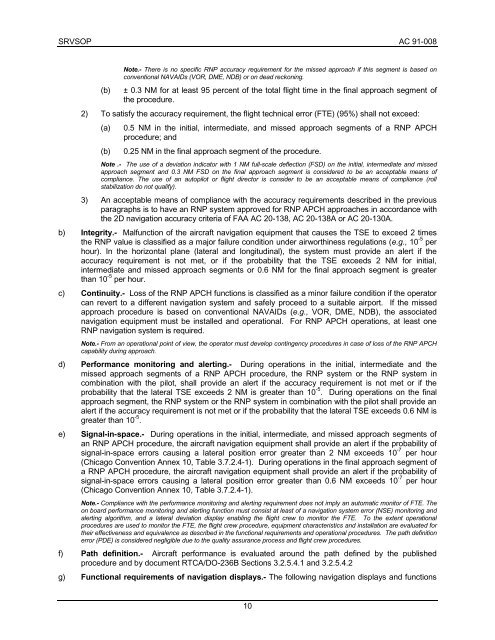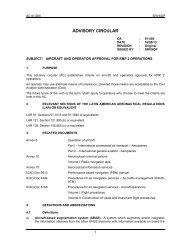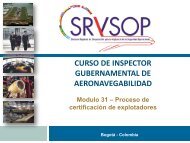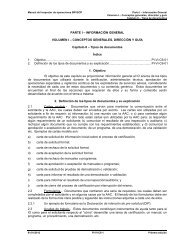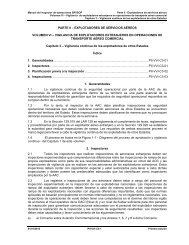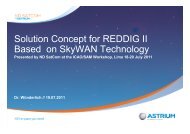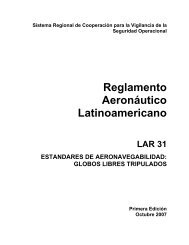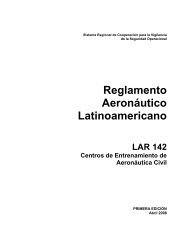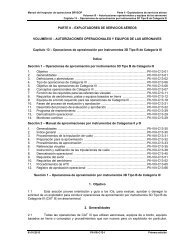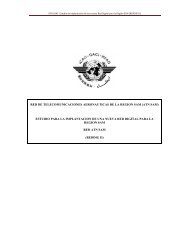CA 91-008 RNP APCH - ICAO
CA 91-008 RNP APCH - ICAO
CA 91-008 RNP APCH - ICAO
You also want an ePaper? Increase the reach of your titles
YUMPU automatically turns print PDFs into web optimized ePapers that Google loves.
SRVSOP AC <strong>91</strong>-<strong>008</strong><br />
Note.- There is no specific <strong>RNP</strong> accuracy requirement for the missed approach if this segment is based on<br />
conventional NAVAIDs (VOR, DME, NDB) or on dead reckoning.<br />
(b) ± 0.3 NM for at least 95 percent of the total flight time in the final approach segment of<br />
the procedure.<br />
2) To satisfy the accuracy requirement, the flight technical error (FTE) (95%) shall not exceed:<br />
(a) 0.5 NM in the initial, intermediate, and missed approach segments of a <strong>RNP</strong> <strong>APCH</strong><br />
procedure; and<br />
(b) 0.25 NM in the final approach segment of the procedure.<br />
Note .- The use of a deviation indicator with 1 NM full-scale deflection (FSD) on the initial, intermediate and missed<br />
approach segment and 0.3 NM FSD on the final approach segment is considered to be an acceptable means of<br />
compliance. The use of an autopilot or flight director is consider to be an acceptable means of compliance (roll<br />
stabilization do not qualify).<br />
3) An acceptable means of compliance with the accuracy requirements described in the previous<br />
paragraphs is to have an <strong>RNP</strong> system approved for <strong>RNP</strong> <strong>APCH</strong> approaches in accordance with<br />
the 2D navigation accuracy criteria of FAA AC 20-138, AC 20-138A or AC 20-130A.<br />
b) Integrity.- Malfunction of the aircraft navigation equipment that causes the TSE to exceed 2 times<br />
the <strong>RNP</strong> value is classified as a major failure condition under airworthiness regulations (e.g., 10 -5 per<br />
hour). In the horizontal plane (lateral and longitudinal), the system must provide an alert if the<br />
accuracy requirement is not met, or if the probability that the TSE exceeds 2 NM for initial,<br />
intermediate and missed approach segments or 0.6 NM for the final approach segment is greater<br />
than 10 -5 per hour.<br />
c) Continuity.- Loss of the <strong>RNP</strong> <strong>APCH</strong> functions is classified as a minor failure condition if the operator<br />
can revert to a different navigation system and safely proceed to a suitable airport. If the missed<br />
approach procedure is based on conventional NAVAIDs (e.g., VOR, DME, NDB), the associated<br />
navigation equipment must be installed and operational. For <strong>RNP</strong> <strong>APCH</strong> operations, at least one<br />
<strong>RNP</strong> navigation system is required.<br />
Note.- From an operational point of view, the operator must develop contingency procedures in case of loss of the <strong>RNP</strong> <strong>APCH</strong><br />
capability during approach.<br />
d) Performance monitoring and alerting.- During operations in the initial, intermediate and the<br />
missed approach segments of a <strong>RNP</strong> <strong>APCH</strong> procedure, the <strong>RNP</strong> system or the <strong>RNP</strong> system in<br />
combination with the pilot, shall provide an alert if the accuracy requirement is not met or if the<br />
probability that the lateral TSE exceeds 2 NM is greater than 10 -5 . During operations on the final<br />
approach segment, the <strong>RNP</strong> system or the <strong>RNP</strong> system in combination with the pilot shall provide an<br />
alert if the accuracy requirement is not met or if the probability that the lateral TSE exceeds 0.6 NM is<br />
greater than 10 -5 .<br />
e) Signal-in-space.- During operations in the initial, intermediate, and missed approach segments of<br />
an <strong>RNP</strong> <strong>APCH</strong> procedure, the aircraft navigation equipment shall provide an alert if the probability of<br />
signal-in-space errors causing a lateral position error greater than 2 NM exceeds 10 -7 per hour<br />
(Chicago Convention Annex 10, Table 3.7.2.4-1). During operations in the final approach segment of<br />
a <strong>RNP</strong> <strong>APCH</strong> procedure, the aircraft navigation equipment shall provide an alert if the probability of<br />
signal-in-space errors causing a lateral position error greater than 0.6 NM exceeds 10 -7 per hour<br />
(Chicago Convention Annex 10, Table 3.7.2.4-1).<br />
Note.- Compliance with the performance monitoring and alerting requirement does not imply an automatic monitor of FTE. The<br />
on board performance monitoring and alerting function must consist at least of a navigation system error (NSE) monitoring and<br />
alerting algorithm, and a lateral deviation display enabling the flight crew to monitor the FTE. To the extent operational<br />
procedures are used to monitor the FTE, the flight crew procedure, equipment characteristics and installation are evaluated for<br />
their effectiveness and equivalence as described in the functional requirements and operational procedures. The path definition<br />
error (PDE) is considered negligible due to the quality assurance process and flight crew procedures.<br />
f) Path definition.- Aircraft performance is evaluated around the path defined by the published<br />
procedure and by document RT<strong>CA</strong>/DO-236B Sections 3.2.5.4.1 and 3.2.5.4.2<br />
g) Functional requirements of navigation displays.- The following navigation displays and functions<br />
10


